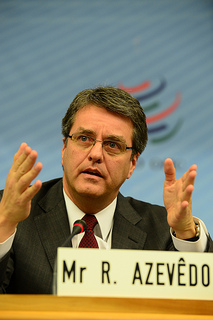The Global Trading System Aims to Improve Children’s Lives
GENEVA, Apr 22 (IPS) - Although some people don't see the connection, the global trading system is aimed at creating some of the essential conditions needed to improve children's lives and their prospects in the future.
We can identify three flash points where trade and children's interests intersect, and where perhaps we can do a bit more to maximise our impact. One relates to developed countries, and two to developing nations.
The first point is this: the crisis in recent years has hit many western economies hard — and one of the most worrying effects has been very high levels of youth unemployment.

Levels have topped 50 percent in some countries. The effects of this are very significant - and are much more damaging than simply the loss of productive capacity in the economy.
Surveys of young people highlight the corrosive effect that unemployment can have on their confidence, motivation, and view of the future - raising the spectre of a "lost generation".
Trade can be part of the solution, because one of the key differences that trade makes is through job creation.
The World Trade Organisation (WTO) reached a major multilateral trade deal in Bali last December which could make a big difference here, as economists predict that it could create 21 million jobs.
Of course the relationship of cause and effect is complex. The WTO conducted a major study on this issue with the Organisation for Economic Cooperation and Development (OECD) and others in 2012. The evidence shows that trade can play a powerful role - but to be effective, trade reforms have to be embedded in supportive policies.
Countries where trade openness has failed to stimulate growth commonly have unstable macroeconomic policies, inadequate property rights, insufficient public investment in overcoming supply-side constraints, or other socio-political limitations.
So for the positive effects of trade to be realised in tackling youth unemployment, we need to recognise the inter-linkages to other areas of policy.
Export-orientated jobs typically pay higher wages to their workers. In Western Europe those working in export-focused companies collect a 10-20 percent premium over the average wage. And in sub-Saharan Africa that figure is even higher, at 34 percent.
Of course there are challenges here too in ensuring that low-skilled workers are not left behind.
My second point is about the persistent tragedy of child poverty.
By supporting economic growth and poverty alleviation, trade can be an important engine for change, and therefore can make a significant difference to children's prospects.
The leaders of the Young Lives survey conducted by Oxford University over 15 years in India, Ethiopia, Peru and Vietnam found that growth provides financial space for governments and families to invest in children and create improved infrastructure and opportunity.
The fact that the Millennium Development Goal to halve the rate of extreme poverty by 2015 was met well ahead of time was illustrative of this.
Take China, where the pursuit of an export-led growth model has led it to become the world's second largest economy and now the world's biggest trading nation. At the same time it has reduced the poverty level from 60 to 12 percent between 1990 and 2010.
Other economies have followed a similar trajectory, using the trading system to rapidly expand economic growth and slash rates of extreme poverty.
Look at Vietnam or the recent graduates from least developed country status: Samoa, Cape Verde and the Maldives. They show again the difference that trade and increased investment can make in achieving more inclusive socio-economic development.
However the rate of poverty reduction as a whole is not always matched in the area of child poverty. Again, the Young Lives survey argues that while economic growth is important, what matters more for children is the nature or quality of that growth.
We have to harness growth more effectively and convert it into social change that benefits poor children and their families. This is an urgent challenge for policy-makers at the international level to provide the right frameworks and mechanisms to support quality growth, and at the domestic level to ensure that no-one falls behind, particularly children.
So the debate that is currently underway to design the successors to the Millennium Development Goals will be crucial here, not least as it will dictate the agenda until 2030.
My final point is that lifting children out of poverty is essential, but it is not enough.
We need to look at children's lives in a more holistic way.
Robert F. Kennedy warned of the narrowness of economic measurements. He said: "The gross national product does not allow for the health of our children, the quality of their education or the joy of their play... It measures everything, in short, except that which makes life worthwhile."
Of course this is what the Human Development Index is all about - the need to place people at the centre of policy-making.
Trade is not just about dollars and cents. We need to look at the wider environment.
I believe that trade can help to create the conditions in which children can lead better lives. And at the most fundamental level, we can do this through supporting the family - by reducing the potential for conflict, helping to create a stable environment and predictable conditions, and supporting higher income levels.
This, in turn, can support better education and healthcare, while improved connections through trade also support wider access to medicine.
Amartya Sen, one of the creators of the Human Development Index, argues that true development comes through freedom.
And I believe that by encouraging openness, cooperation and democracy, trade supports this as well. (END/COPYRIGHT IPS)
© Inter Press Service (2014) — All Rights ReservedOriginal source: Inter Press Service
 Global Issues
Global Issues